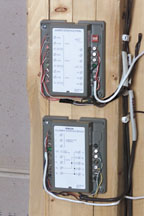

A 1999 survey commissioned by Honeywell identified the “Top 10 Pet Peeves” of homeowners. “The number one response was inconsistent temperatures in the home,” related Andrew Hulse, zoning business unit leader for Honeywell. It was cited by 54.6% of the respondents. Zoning, naturally, solves this problem.
In 1990, Professional Builder magazine did a survey asking homebuyers what optional features they most wanted in their homes. Zoning was ranked sixth out of 72 possible options, mentioned by 61.3% of homebuyers.
In a 1999 survey published in the same magazine that asked Baby Boomers to rank home features and options, zoning came in second. Many of the items that ranked below it, such as a fireplace and a security system, “are almost seen as standard today,” said Hulse.
Despite the desirability of zoning as a home option, however, at present it only goes in about 5% of all hvac equipment installations, he said. “It’s a pretty low penetration at this time.”
Why so low? “The biggest challenge is that homeowners don’t know it’s readily available,” Hulse stated.
The hvac industry has traditionally been slow to take on new technology, he noted. “Overall, very few contractors have capitalized on this business opportunity,” he said. Once contractors do take on zoning, they find they get high sales rates and their profit per job dramatically increases, he said.
A complex of 138 town homes built in Atlanta, GA, illustrates how offering zoning can maximize profits. Zoning was to be standard in the complex. But when the first 33 units went up, there was a miscommunication between the builder and contractor, and the homes were built without zoning. So zoning was offered as an upgrade option to those homebuyers, and 32 out of 33 took it, reported Hulse.

A Little Scary
Zoning may actually scare some contractors a little bit, he said, but once they attend training, they “are amazed at how easy it can be.”John Edwards, national field sales zoning leader and the company’s zoning training expert, agrees that some contractors may be intimidated. “The key is making them comfortable with something they’re not used to doing.”
To ease installation, Honey-well’s new Networked Zoning System is self-configuring and simple to set up, said Hulse. It is a “true communicating system” — the components all talk to one another through peer-to-peer communications.
The system uses a three-wire connection between all devices; no special wiring is required. Also, it allows the global variables for all thermostats to be set up at a single thermostat.
Another area of concern for some contractors is what to do with excess airflow. Some zoned systems may use what is called a dump zone, an area of a building where excess air is unloaded. A dump zone is not recommended, declared Hulse, as it’s a waste of energy.
“There’s no control in that zone,” he said.
A dump zone can also influence an adjacent zone, noted Edwards, and “get a building out of balance pretty quickly.” A bypass damper is the recommended practice instead of a dump zone.
Contractors may sometimes use multiple hvac systems to zone when the square footage doesn’t require it, Hulse commented. This is a very expensive way to go, he continued. Zone control with dampers is simpler and would provide these contractors with higher profit potential.
Regarding new home installations vs. retrofit, Hulse said that some contractors exclusively do zoning in new homes and some exclusively do retrofit work. It’s probably applied more in new homes, he observed.
Edwards said that in the Midwest and Northeast it’s more popular in new home construction. But, he noted, “We have a tremendous amount of retrofit out West.”
The cost for a basic new construction zoning system at the low end is $1,200 to $1,500, remarked Hulse. At the high end, it’s in the neighborhood of $1,000 to $1,500 per zone.
Networked Zoning is likewise about $1,000 to $1,500 per zone.
Energy savings with zoning can be significant.
“Studies have shown there is somewhere in the neighborhood of 25% to 30% energy savings,” he said, “when compared to a central system with a single thermostat and no setback.”
Payback varies widely, but in general you can expect about a five-year payback, said Hulse.

Stressing the Four C’s
To sell zoning, Honeywell stresses what Hulse calls the four C’s:1. Comfort — It eliminates temperature differences in the home and improves comfort.
2. Convenience — Homeowners can adjust the thermostat in the location where they’re at.
3. Conservation — It saves energy, reducing heating and cooling bills.
4. Common sense — You wouldn’t put up with one light switch for all the lights in the house. A thermostat for every zone makes sense.
Edwards, who wrote the company’s Forced Air Zoning System Design Manual, also has developed a retrofit zoning checklist for contractors. Some of the items on the list include:
Edwards added, “The best tip we could ever give a contractor is to get informed, get into some training, and see how easy it is.”
For more information, contact Hulse at 763-954-6842; andrew.hulse@honeywell.com (e-mail). Contact Edwards at 909-923-2950; john.edwards@honeywell.com (e-mail).
Sidebar: NEMA Seeks Support
ROSSLYN, VA — The National Electrical Manufacturers Association (NEMA) told the Senate Committee on Energy and Natural Resources recently that the use of energy-efficient products and systems could result in significant savings in the public and private sectors. The association encouraged the federal government to promote the use of such technologies.The Senate committee held hearings to consider the pros and cons of several pieces of legislation in that chamber of Congress. NEMA president Malcolm O’Hagan told the committee, “A comprehensive electrical energy policy should rely on affordable, proven technologies to address energy supply and demand.
“It is critical to understand that energy efficiency and conservation doesn’t mean sacrifice and reduced access, but rather doing more with existing capacity by achieving a reduction in energy usage through the use of more-efficient products and systems.”
Publication date: 07/30/2001


Report Abusive Comment